“Top 10 Highest Buildings of the World”
10 Highest Buildings
. The highest buildings of the world not only redefine skylines but also set new standards in architecture and engineering. Skyscrapers have always been a testament to human ingenuity and ambition. Standing tall as a beacon of light they epitomize advancement, advancement, and the ever unrelenting pursuit of superior quality, innovation, and the relentless pursuit of greatness. In this article, we will delve into the top 10 highest buildings of the world, exploring their unique features, historical significance, and the impact they have on their respective cities.
Overview of Skyscrapers and Their Significance
Skyscrapers are more than just tall buildings; they are icons of urban development and economic prowess. They house offices, hotels, residential units, and even recreational facilities, making them hubs of activity and culture. The highest buildings of the world often become landmarks, attracting tourists and boosting local economies. Moreover, they showcase advancements in construction technology and sustainable design practices. In an ever-growing world, skyscrapers represent humanity’s desire to reach new heights, both literally and metaphorically.
Criteria for Ranking the Highest Buildings
When ranking the highest buildings of the world, several criteria are considered. The primary measure is architectural height, which includes spires but excludes antennas and other functional extensions. The buildings are also evaluated based on their structural and floor height. These parameters ensure a fair comparison and highlight the true giants of the urban landscape. As we explore the tallest buildings, it’s essential to understand these standards to appreciate the magnitude of these architectural marvels.
1. Burj Khalifa, Dubai
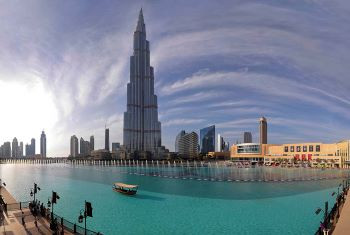
- Architectural Features and Design
The Burj Khalifa in Dubai stands as the pinnacle of architectural achievement. Designed by Adrian Smith of Skidmore, Owings & Merrill, this iconic skyscraper features a unique, stepped design inspired by Islamic architecture. The Y-shaped floor plan provides structural stability and maximizes views of the Persian Gulf. Clad in reflective glass and aluminum, the exterior shimmers under the desert sun, creating a visual spectacle. With its cutting-edge design and innovative engineering, the Burj Khalifa is undoubtedly one of the highest buildings of the world.
- Record-Breaking Statistics
Standing at an astounding 828 meters (2,717 feet), the Burj Khalifa holds the title of the tallest building in the world since its completion in 2010. It boasts 163 floors, the highest observation deck, and the longest elevator travel distance. The building’s construction required unprecedented engineering feats, including the use of the world’s highest pumping of concrete. The Burj Khalifa is a testament to human capability and ambition, setting records that may stand for years to come.
2. Shanghai Tower, China
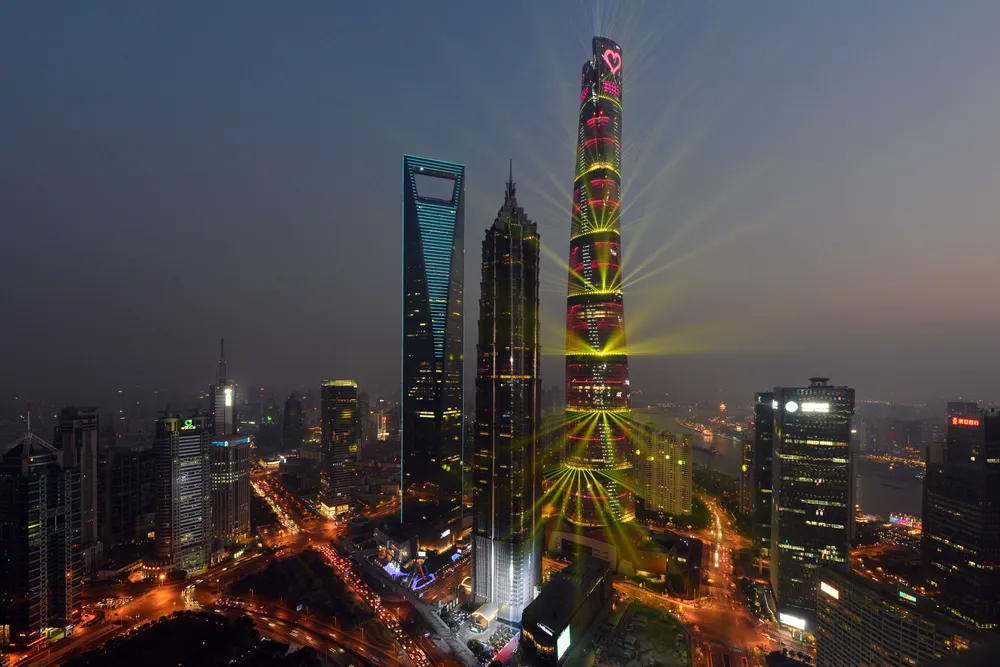
- Unique Structural Elements
The Shanghai Tower, located in the heart of Shanghai’s financial district, is a marvel of modern engineering. Its distinctive twisted design, created by Gensler, reduces wind loads and enhances structural stability. The building’s double-layered glass façade insulates the interior, reducing energy consumption. With nine distinct zones, including office spaces, hotels, and cultural venues, the Shanghai Tower embodies multifunctional urban living. As one of the highest buildings of the world, its unique structural elements showcase the blend of aesthetics and functionality.
Impact on the Skyline
Rising to 632 meters (2,073 feet), the Shanghai Tower is the second tallest building globally. It complements the adjacent Jin Mao Tower and the Shanghai World Financial Center, creating a trio of architectural giants. The tower’s twisting form and shimmering façade have redefined Shanghai’s skyline, making it a symbol of the city’s rapid modernization. The Shanghai Tower’s presence on the horizon signifies China’s growing influence in global architecture and urban development.
3. Abraj Al-Bait Clock Tower, Saudi Arabia
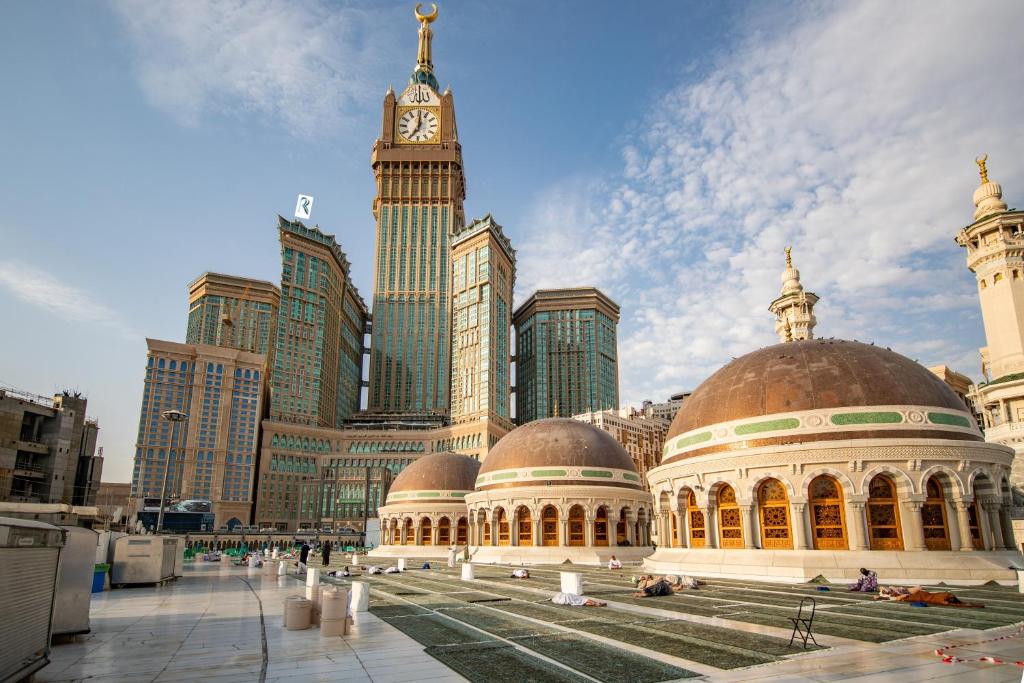
- Historical and Cultural Importance
The Abraj Al-Bait Clock Tower, part of a government-owned complex in Mecca, holds profound historical and cultural significance. It serves millions of pilgrims visiting the holy city for the annual Hajj. The clock tower, with its massive clock faces visible from miles away, is a beacon for worshippers. The building also houses a luxurious hotel, residential units, and prayer rooms, catering to the needs of visitors. As one of the highest buildings of the world, it stands as a testament to Saudi Arabia’s rich heritage and dedication to hospitality.
- Architectural Innovations
Reaching a height of 601 meters (1,971 feet), the Abraj Al-Bait Clock Tower is an engineering marvel. Its construction involved innovative techniques to manage the immense weight and ensure structural integrity. The clock tower features the world’s largest clock face, adorned with intricate Islamic designs and gold detailing. The building’s exterior combines traditional Islamic architecture with modern materials, creating a harmonious blend of old and new. The Abraj Al-Bait Clock Tower exemplifies the fusion of cultural heritage and contemporary design.
4. Ping An Finance Centre, China
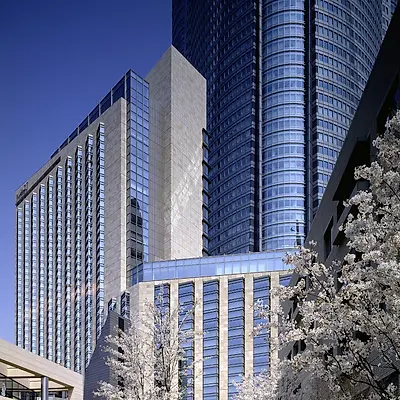
- Modern Design and Construction
The Ping An Finance Centre in Shenzhen, China, is a symbol of modern design and advanced construction. Designed by Kohn Pedersen Fox Associates, the skyscraper features a sleek, tapered form that enhances its aerodynamic performance. The façade of the building was designed and clad in stainless steel with the backdrop of the rising skyline of the city. Inside, the structure offers a mix of office spaces, conference rooms, retail outlets, and observation decks. The Ping An Finance Centre is not only one of the highest buildings of the world but also a testament to contemporary architectural innovation.
- Notable Features and Facilities
At 599 meters (1,965 feet), the Ping An Finance Centre ranks among the tallest buildings globally. It houses the world’s highest observation deck, offering panoramic views of Shenzhen and beyond. The building incorporates state-of-the-art facilities, including high-speed elevators, advanced safety systems, and sustainable technologies. The Ping An Finance Centre’s design and amenities reflect the ambitions of a rapidly developing city, positioning it as a landmark of urban progress.
5. Lotte World Tower, South Korea
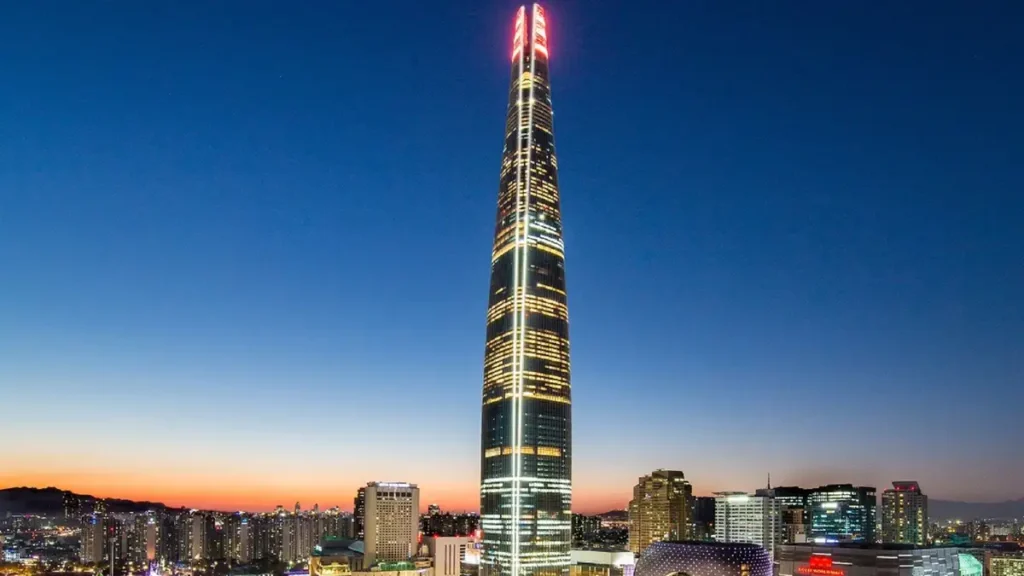
- Engineering Marvels
Lotte World Tower which is in Seoul city, South Korea is one of the engineering miracles. Designed by Kohn Pedersen Fox Associates, the tower features a sleek, tapered silhouette that rises gracefully into the sky. The building’s structure incorporates advanced materials and construction techniques to withstand seismic activity and strong winds. The tower’s design draws inspiration from traditional Korean art and architecture, creating a modern yet culturally resonant landmark. As one of the highest buildings of the world, the Lotte World Tower exemplifies cutting-edge engineering and architectural excellence.
- Key Highlights and Attractions
Standing at 555 meters (1,819 feet), the Lotte World Tower is the tallest building in South Korea and one of the tallest globally. It houses a variety of attractions, including observation decks, a luxury hotel, office spaces, and retail outlets. The tower’s Sky Deck, located on the 118th floor, offers breathtaking views of Seoul and the surrounding area. Additionally, the building features a concert hall, an aquarium, and a rooftop garden, providing a diverse range of experiences for visitors. The Lotte World Tower is a testament to South Korea’s architectural ambition and innovative spirit.
6. One World Trade Center, USA

- Symbolic Significance
The One World Trade Center otherwise called the Freedom Tower is therefore symbolic of the spirit of afresh polishing after a tumble. Built on the site of the original World Trade Center complex that was destroyed during the September 11 attacks, it stands as a tribute to the victims and a testament to the strength and perseverance of New York City and the United States. As one of the highest buildings of the world, its design incorporates elements that reflect its historical and emotional significance. v. This towering edifice is not just an architectural marvel but a beacon of hope and renewal for people around the world.
- Advanced Safety Features
One World Trade Center boasts state-of-the-art safety features that make it one of the most secure skyscrapers globally. Designed with extensive safety measures, it includes a reinforced concrete core, wider staircases, and enhanced fireproofing materials. The building also has a dedicated emergency communication system and multiple evacuation routes to ensure the safety of occupants. As one of the highest buildings of the world, its design incorporates advanced technologies to withstand potential threats and natural disasters, ensuring a safe environment for its tenants and visitors. These innovative safety features set a new standard for skyscraper design and construction.
7. Guangzhou CTF Finance Centre, China

- Technological Advancements
The Guangzhou CTF Finance Centre, located in the bustling city of Guangzhou, China, is a testament to technological innovation in architecture. Standing at 530 meters (1,739 feet), it features cutting-edge design elements and advanced building systems. The tower is equipped with the world’s fastest elevators, capable of reaching speeds up to 20 meters per second, providing swift and efficient vertical transportation. As one of the highest buildings of the world, it incorporates a variety of sustainable technologies, including high-efficiency chillers, energy recovery systems, and a comprehensive water management system. These technological advancements contribute to the building’s energy efficiency and environmental sustainability.
- Environmental Considerations
Environmental sustainability is a core aspect of the Guangzhou CTF Finance Centre’s design. The building utilizes energy-efficient systems to reduce its carbon footprint and optimize resource use. Features such as double-glazed windows, green roofs, and rainwater harvesting systems enhance its environmental performance. As one of the highest buildings of the world, it serves as a model for green building practices, demonstrating how skyscrapers can contribute to environmental conservation. The integration of sustainable design principles ensures that the Guangzhou CTF Finance Centre meets modern ecological standards while providing a comfortable and healthy environment for its occupants.
8. Tianjin CTF Finance Centre, China
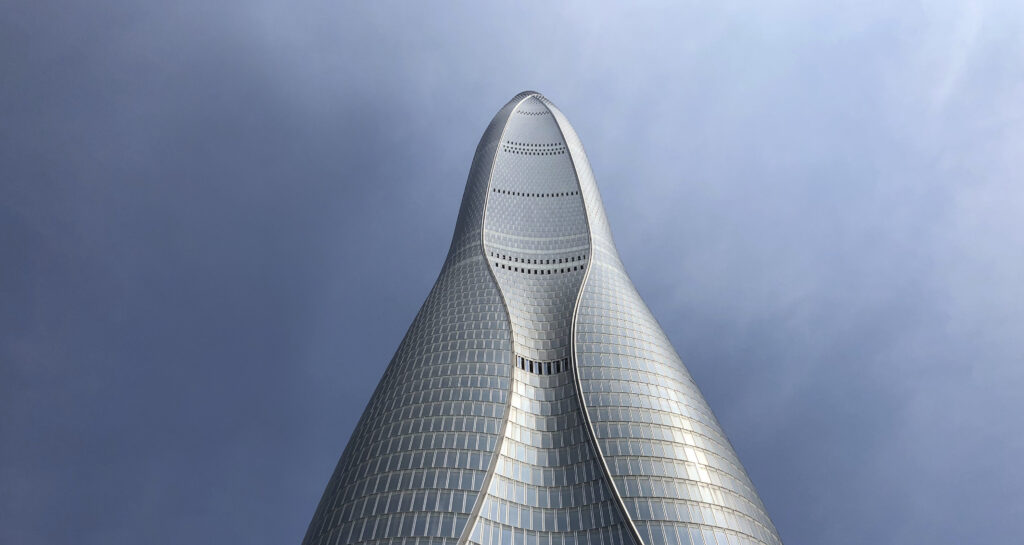
- Design Philosophy
The Tianjin CTF Finance Centre is renowned for its innovative design philosophy that combines aesthetics with functionality. Designed by the architectural firm Skidmore, Owings & Merrill, the tower features a sleek, crystalline form that minimizes wind resistance and enhances structural stability. The building’s tapered shape and aerodynamic profile reduce wind loads, allowing for a more slender and elegant silhouette. As one of the highest buildings of the world, the Tianjin CTF Finance Centre exemplifies the integration of artistic vision and engineering precision, creating a visually stunning and structurally sound skyscraper.
- Impact on Urban Development
This paper investigates and analyzes how the construction of the Tianjin CTF Finance Centre has affected the development of Tianjin city in China. . As a landmark structure, it has become a focal point for the city’s financial district, attracting businesses, tourists, and investors. The tower’s presence has spurred economic growth and development in the surrounding area, contributing to the city’s modernization and global recognition. As one of the highest buildings of the world, it symbolizes Tianjin’s aspirations and potential as a major financial hub. The building’s impact extends beyond its physical presence, influencing urban planning and development strategies in the region.
9. CITIC Tower, China

- Architectural Style
China Zun or CITIC Tower is one of the most spectacular buildings found in Beijing – the capital city of China.. Housing 108 floors it currently ranks as the tallest building in the city and within the top ten biggest structures on the planet. . The tower’s design draws inspiration from an ancient Chinese wine vessel called a “Zun,” featuring a gently curving profile that tapers towards the base and the top. This unique architectural style not only creates a striking visual effect but also enhances the building’s structural efficiency. The tower has a beautiful shape and includes design-solutions that help it become one of the most important landmarks of Beijing.
- Role in City Infrastructure
CITIC Tower plays a crucial role in Beijing’s city infrastructure, serving as a hub for commercial activities and a symbol of modern urban development. The building houses offices, retail spaces, and a luxury hotel, providing a multifunctional space for business and leisure.
10. TAIPEI 101, Taiwan
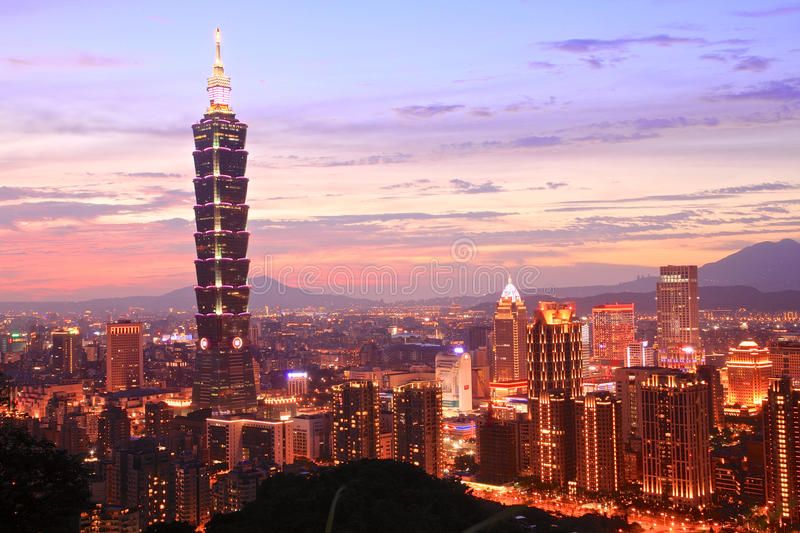
- Historical Context
TAIPEI 101, once the tallest building in the world, holds significant historical and cultural importance. Completed in 2004, it stands at 508 meters (1,667 feet) and was designed to withstand the region’s frequent earthquakes and typhoons. The building’s design incorporates elements of traditional Asian architecture, symbolizing prosperity and good fortune. As one of the highest buildings of the world, TAIPEI 101 serves as a landmark of Taiwanese innovation and resilience. Its construction marked a milestone in Taiwan’s development, showcasing the nation’s ability to achieve architectural excellence on a global scale.
- Structural and Aesthetic Features
TAIPEI 101 is renowned for its advanced structural engineering and distinctive aesthetic features. The building’s design includes a series of eight segments, each consisting of eight floors, reflecting the auspicious number eight in Chinese culture. The exterior is clad in green glass, representing bamboo shoots, a symbol of growth and sustainability. The tower is equipped with a massive tuned mass damper, a 660-ton device that helps stabilize the building during earthquakes and strong winds. As one of the highest buildings of the world, TAIPEI 101 combines beauty and functionality, setting a benchmark for skyscraper design and construction.
FAQs
What is the tallest building in the world?
- The Burj Khalifa in Dubai, UAE, is the tallest building in the world, standing at 828 meters (2,717 feet).
Which building held the title of the tallest before the Burj Khalifa?
- The Taipei 101 in Taiwan held the title of the tallest building in the world from 2004 until the Burj Khalifa was completed in 2010.
What are some unique features of the Shanghai Tower?
- The Shanghai Tower features a twisted design to reduce wind loads and a double-layered glass façade for energy efficiency2.
How tall is the One World Trade Center?
- The One World Trade Center in New York City stands at 541 meters (1,776 feet), symbolizing the year of American independence2.
What makes the Guangzhou CTF Finance Centre environmentally friendly?
- The Guangzhou CTF Finance Centre incorporates sustainable technologies like high-efficiency chillers and rainwater harvesting systems to reduce its environmental impact2.
FAQs
What is the tallest building in the world?
The Burj Khalifa in Dubai, UAE, is the tallest building in the world, standing at 828 meters (2,717 feet).
Which building held the title of the tallest before the Burj Khalifa?
The Taipei 101 in Taiwan held the title of the tallest building in the world from 2004 until the Burj Khalifa was completed in 2010.
What are some unique features of the Shanghai Tower?
The Shanghai Tower features a twisted design to reduce wind loads and a double-layered glass façade for energy efficiency.
How tall is the One World Trade Center?
The One World Trade Center in New York City stands at 541 meters (1,776 feet), symbolizing the year of American independence.
What makes the Guangzhou CTF Finance Centre environmentally friendly?
The Guangzhou CTF Finance Centre incorporates sustainable technologies like high-efficiency chillers and rainwater harvesting systems to reduce its environmental impact.
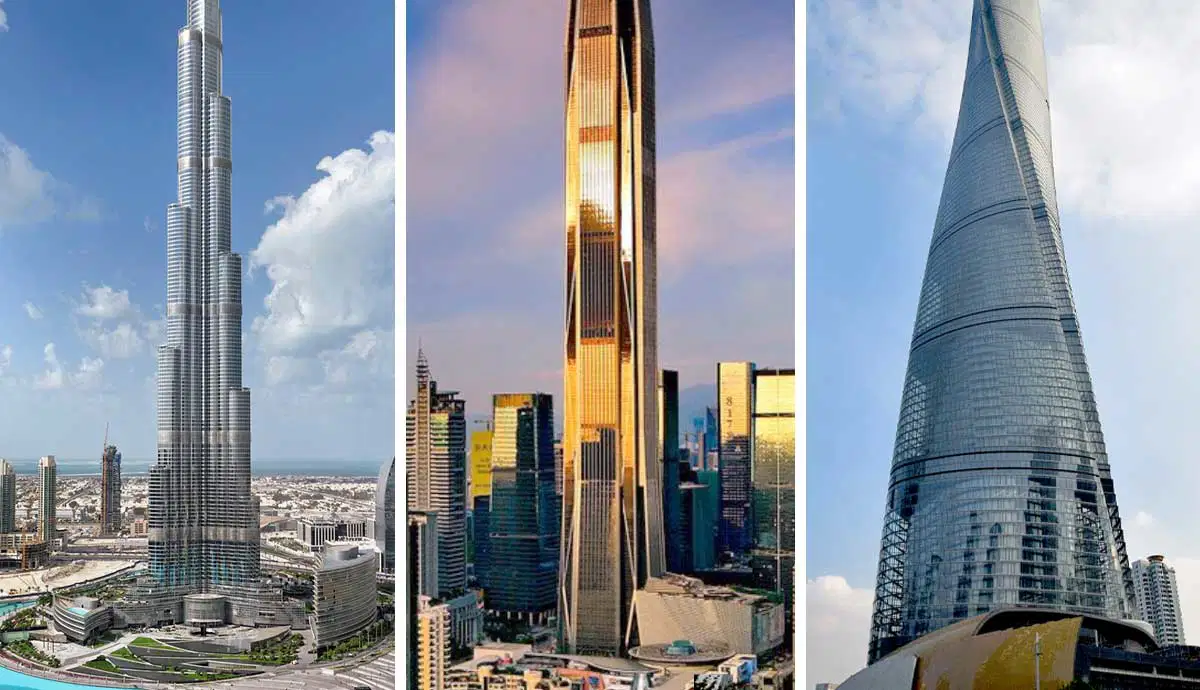






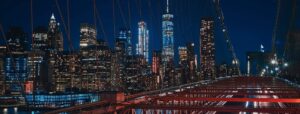






Post Comment